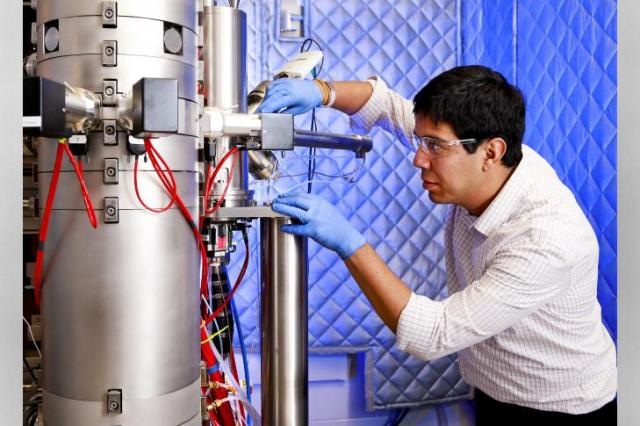A new electron microscopy technique created by a group of researchers from the Department of Energy’s Oak Ridge National Laboratory and Uppsala University, Sweden, allows scientists to identify magnetism at the atomic level. The scientists came out with a different approach by using optical distortions that were usually eliminated.
 ORNL’s Juan Carlos Idrobo helped develop an electron microscopy technique to measure magnetism at the atomic scale. Credit: ORNL
ORNL’s Juan Carlos Idrobo helped develop an electron microscopy technique to measure magnetism at the atomic scale. Credit: ORNL
“It’s a new approach to measure magnetism at the atomic scale,” said ORNL’s Juan Carlos Idrobo. “We will be able to study materials in a new way. Hard drives, for instance, are made by magnetic domains, and those magnetic domains are about 10 nanometers apart.”
One nanometer is a billionth of a meter, and the scientists are refining their method to gather magnetic signals from single atoms that are 10 times lesser than a nanometer.
If we can understand the interaction of those domains with atomic resolution, perhaps in the future we will able to decrease the size of magnetic hard drives. We won’t know without looking at it.
Juan Carlos Idrobo, ORNL
Scientists have conventionally used scanning transmission electron microscopes to identify where the atoms are positioned within the materials. Scientists can gather more information regarding the behavior of atoms using this new technique.
“Magnetism has its origins at the atomic scale, but the techniques that we use to measure it usually have spatial resolutions that are way larger than one atom,” Idrobo said. “With an electron microscope, you can make the electron probe as small as possible and if you know how to control the probe, you can pick up a magnetic signature.”
By rethinking the basis of electron microscopy referred to as aberration correction, the ORNL-Uppsala group formulated the technique. Scientists have spent many years working towards the elimination of various types of aberrations, which are distortions that come up in the electron-optical lens and leads in blur images.
The scientists purposely introduced a kind of aberration in the electron microscope known as four-fold astigmatism instead of completely eliminating the aberrations. This was done to assemble magnetic signals at the atomic level from a lanthanum manganese arsenic oxide material. The researchers’ theoretical predictions were validated by the experimental study and it was published in a 2014 Physical Review Letters study.
This is the first time someone has used aberrations to detect magnetic order in materials in electron microscopy. Aberration correction allows you to make the electron probe small enough to do the measurement, but at the same time we needed to put in a specific aberration, which is opposite of what people usually do.
Juan Carlos Idrobo, ORNL
Idrobo further states that the new electron microscopic techniques could accompany current methods, like neutron scattering and x-ray spectroscopy that are the foundations for understanding magnetism but have limited spatial resolution.
The Journal of Advanced Structural and Chemical Imaging published this study as “Detecting magnetic ordering with atomic size electron probes”. ORNL’s Juan Carlos Idrobo, Michael McGuire, Claudia Cantoni, Christopher Symons, Ranga Raju Vatsavai, and Andrew Lupini; and Uppsala University’s Ján Rusz and Jakob Spiegelberg are the co-authors.
The Center for Nanophase Materials Sciences, a DOE Office of Science User Facility at ORNL conducted the electron microscopy experiments. DOE’s Office of Science funded this research.
UT-Battelle manages ORNL for the Department of Energy's Office of Science, the sole largest supporter of basic research in the physical sciences in the US. DOE’s Office of Science is currently focusing on some of the most critical challenges.